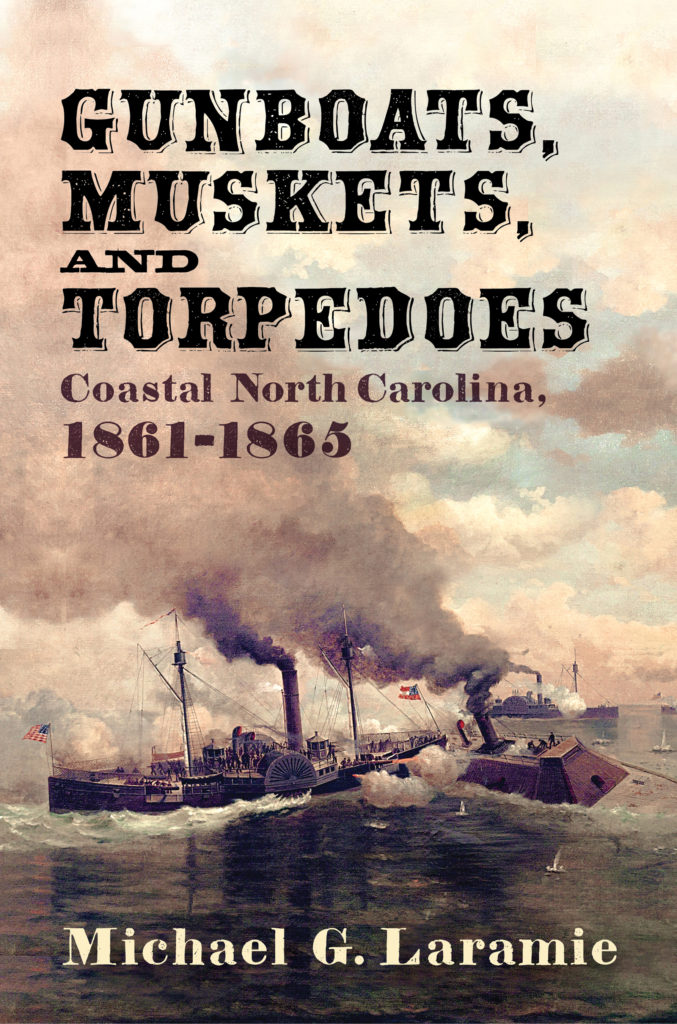

Gunboats, Muskets, and Torpedoes
Coastal North Carolina, 1861–1865
Select Your Format:
Hardback$30.00eBook
$30.00 Add to Cart Save 25% on every book by joining our Book Club


Select Your Format:
HardbackThe Clash for a Critical Region that Lasted the Entire Civil War
From the first shots at Cape Hatteras in the summer of 1861 to the fall of Fort Fisher in early 1865, the contest for coastal North Carolina during the American Civil War was crucial to the Union victory. With a clear naval superiority over the South, the North conducted blockading and amphibious operations from Virginia to Texas, including the three-hundred-mile seacoast of North Carolina. With its Pamlico and Albemarle Sounds—fed by navigable rivers that reached deep into the interior—and major Confederate port of Wilmington, the Carolina coast was essential for the distribution of foreign goods and supplies to Confederate forces in Virginia and elsewhere. If the Union was able to capture Wilmington or advance on the interior waters, they would cripple the South’s war efforts.
In Gunboats, Muskets, and Torpedoes: Coastal North Carolina, 1861–1865, award-winning historian Michael G. Laramie chronicles both the battle over supplying the South by sea as well as the ways this region proved to be a fertile ground for the application of new technologies. With the advent of steam propulsion, the telegraph, rifled cannon, repeating firearms, ironclads, and naval mines, the methods and tactics of the old wooden walls soon fell to those of this first major conflict of the industrial age. Soldiers and sailors could fire farther and faster than ever before. With rail transportation available, marches were no longer weeks but days or even hours, allowing commanders to quickly shift men and materials to meet an oncoming threat or exploit an enemy weakness. Fortifications changed to meet the challenges imposed by improved artillery, while the telegraph stretched the battlefield even further. Yet for all the technological changes, many of which would be harbingers of greater conflicts to come, the real story of this strategic coast is found in the words and actions of the soldiers and sailors who vied for this region for nearly four years. It is here, where the choices made—whether good or bad, misinformed, or not made at all—intersected with logistical hurdles, geography, valor, and fear to shape the conflict; a conflict that would ultimately set the postwar nation on track to becoming a modern naval power.

Michael G. Laramie is the author of King William’s War: The First Contest for North America, 1689–1697, winner of the New York Society of Colonial Wars Annual Book Award, and By Wind and Iron: Naval Campaigns in the Champlain Valley, 1665–1815. He lives with his family in Arizona.
“Countless books have been written about the Civil War’s land battles and campaigns, but few have covered the war’s naval history as well as author Michael Laramie’s excellent book on the combined Army-Navy operations on North Carolina’s 300-mile coastline from 1861-1865.”—Military Officer
“The narrative presentation of the material strikes a nearly perfect balance between descriptive military detail and popular accessibility (a craft undoubtedly honed during the creation of the author’s award-winning work on Colonial-era land and naval campaigns). a fitting candidate (arguably the best overview so far written) for first-line introduction to the Civil War in eastern North Carolina. General readers will find Laramie’s narrative style highly engaging, and the author’s comprehensive treatment of campaigns and battles possesses more than enough detail to attract experienced Civil War readers wanting to learn more about the topic.”—Civil War Books and Authors
“Outside of Virginia, no other state saw as much military activity during the Civil War as North Carolina. That is particularly true of the coastal regions of the Tar Heel State, east of Raleigh and the Wilmington & Weldon Railroad that was a vital lifeline for Lee’s Army of Northern Virginia. Several excellent books chronicle specific episodes of the conflict along North Carolina’s 300 miles of coastline—Chris Fonvielle’s The Wilmington Campaign: Last Rays of Departing Hope, Rod Gragg’s Confederate Goliath, and James L. Walker, Jr.’s Rebel Gibraltar all come to mind. Michael G. Laramie’s new offering is a welcome addition to those standards of the state’s Civil War history bookshelves.Laramie does a fine job of telling the story of what may be one of the most important yet neglected theaters of the war. He weaves stories of personal courage with an analysis of how evolving technology impacted how the war was fought. Rifled naval cannon were countered with sand-walled forts that absorbed the pounding blockading ships delivered. Telegraph lines made communication quicker and easier, and trains made moving troops from one battlefield to the next impossibly fast. All the while, the story never loses sight of the heart of the tale, the men who braved rifle and cannon against daunting odds to win. Michael G. Laramie has produced a fine book that spotlights America’s most deadly conflict as it was fought where the tide meets the shore in North Carolina.”—Carolina Chronicles